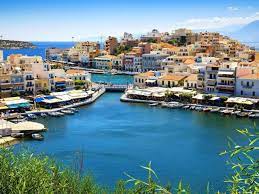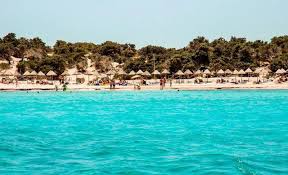Sunny Crete simply has it all!Crete is the largest island in Greece, and the fifth largest one in the Mediterranean Sea. Here, you can admire the remnants of brilliant civilizations, explore glorious beaches, impressive mountainscapes, fertile valleys and steep gorges, and become part of the island’s rich gastronomic culture. Crete is, after all, a small universe teeming with beauties and treasures that you will probably need a lifetime to uncover! Crete is the ideal place for vacation, sunny and warm! Rent a car is obviously very important for individual travellers and groups.  The Sunny Crete weather is lasting for 340 days a year and is helping the drivers to drive safe all around the island. Crete is the “Sunny Crete place to rent a car”, we offer low rates and special advices regarding where to go and where to drive. Weather and Climate conditions in Crete The weather in sunny Crete is characterized by mild, rainy winters and hot, dry summers. The climate of sunny Crete is a temperate Mediterranean climate There are significant differences between the coastal zone and the mountainous areas, as well as between the west and the east part of Crete, when it comes to the weather conditions. The Sunny Crete weather is lasting for 340 days a year and is helping the drivers to drive safe all around the island. Crete is the “Sunny Crete place to rent a car”, we offer low rates and special advices regarding where to go and where to drive. Weather and Climate conditions in Crete The weather in sunny Crete is characterized by mild, rainy winters and hot, dry summers. The climate of sunny Crete is a temperate Mediterranean climate There are significant differences between the coastal zone and the mountainous areas, as well as between the west and the east part of Crete, when it comes to the weather conditions. The mountains of sunny Crete form an East-West barrier to prevailing northerly winds and they trap the clouds sweeping down the aegean. The result is that it may be grey and wet in the north, but sunny on the south coast where often the clouds do not extend over the sea. – Coastal zone: Dry summer, mild winter. The rainy season starts in late October and lasts till March or even April. Snowfalls are extremely rare in the coastal zone of Crete, especially so in the eastern part of the island.- The east part of sunny Crete (Sitia area) is drier and warmer than the west part (Chania district). This is obvious in the vegetation.  Chania of sunny Crete is a lot greener than the desert-like Sitia area.- The same difference applies between the north coast and the south coast of Crete, with the south coast being drier and warmer. Chania of sunny Crete is a lot greener than the desert-like Sitia area.- The same difference applies between the north coast and the south coast of Crete, with the south coast being drier and warmer.– The winter in the mountainous zone of Crete can be very cold with severe snowfalls. It is not unusual for the roads to be closed due to snowfalls. Up in the high summits of Mt Ida and the White Mountains the snow stays until late June. The Weather in sunny Crete Month by Month January: Cold, rainy and windy. There are 15days-2-weeks period during January when the weather is generally good and the winds cease. This period is called the Halcyonides Days. February: Slightly warmer and sunnier than January. The almond trees bloom in February, the first trees to bloom. The weather is unpredictable and cold days alternate with warm ones. March: Usually cold and windy but there are many sunny days too. In March 2001 there was a heat wave with temperatures as high as 30 °C but that was an exception. The first daring swimmers appear. April: Spring time in Crete with medium temperatures and low rainfall. Crete is full of wildflowers and it is magnificent. May: The weather in Crete becomes warm and sunny. Rain is unlikely to occur past May 10. The “meltemi” seasonal North winds have not yet started to blow, the sea is calm and nature is at its best. May is considered the best month for outdoors activities. A jacket will prove useful for the night. June: Sunny Crete and hot. Time for the beach! July and August: Windy and very hot. July and August are the months that the seasonal North winds blow. It is hard to do anything else during these months, than spend the entire day at the beach. Look for a shady place and drink plenty of water. Do not forget your hat and sunscreen. Not the best weather for people who cannot stand high temperatures (30-35 C). September: Sunny, less windy and slightly cooler. Good for outdoors activities. Get a light jacket for the night, especially if you plan to visit any mountainous areas. October: Sunny, very few windy days but some rain will fall, especially in the west part of sunny Crete. The weather is very good for outdoor activities. October is the month that the traditional drink of Crete, raki, is distilled from grape skins. Warm clothes are rarely necessary. November: The weather becomes unpredictable. It may be sunny but there are plenty of rainy and windy days too. Pack a sweater and don’t forget your umbrella. The south winds start and sometimes they carry sand from the Sahara desert. This sand covers the sky of Crete and it creates very unusual weather conditions. December: The weather conditions vary from year to year with a mixture of windy, calm, rainy, sunny, cold and warm days. Pack warm clothes together with your swimming suit. There are days when the temperature along the south coast makes swimming possible and pleasurable. Cretaquarium in Crete, Iráklion: Admire approximately 2,500 Mediterranean and tropical organisms in one of Europe’s largest sea life centres. Cretaquarium offers visitors a unique opportunity to explore the magnificent world of the Mediterranean Sea. From large predatory sharks to tiny sea horses and spectacular jellyfish, the diversity of marine life is presented against a backdrop of Cretan underwater seascapes, such as the rocks at Mátala (South sunny Crete) and the seabed at Vái (Southeast sunny Crete). Kids, a tip for you: Use one of the microscopes here to observe microscopic creatures and understand more about the marine ecosystem!More info: www.cretaquarium.gr (This content has been supplied by the Hellenic Center for Marine Research.)   |
- +30 2810821424
- info@athenscars.gr
- 24hours Service, Resevations +2.00 GMT 09.00-21.00
